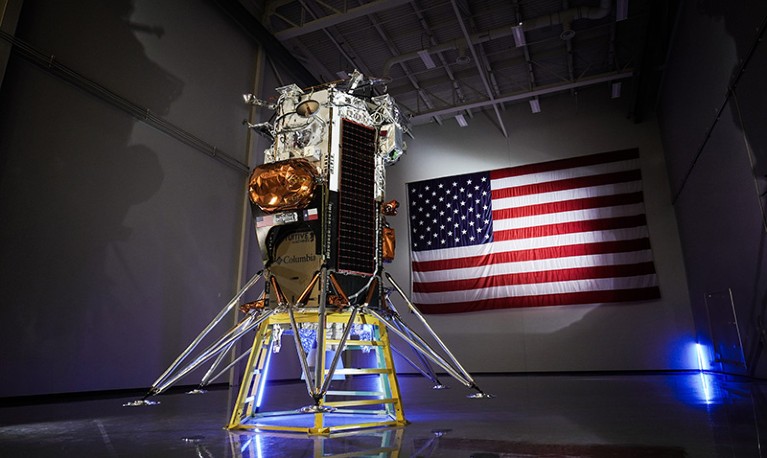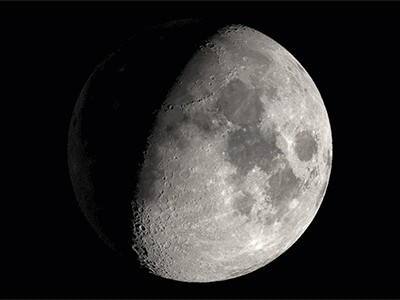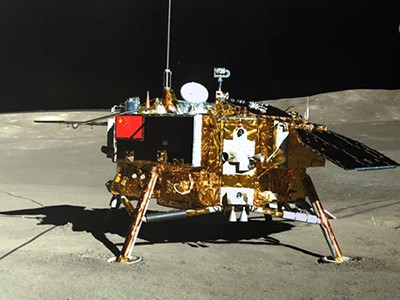
The company Intuitive Machines in Houston, Texas, will try to land its Odysseus spacecraft near the lunar south pole this month.Credit: Intuitive Machines
For the second time this year, a small US aerospace company will try to hurl a spacecraft towards the Moon with the goal of landing it there. If the mission, which aims to launch tonight, succeeds, the lander will become the first private spacecraft to soft-land on the Moon, and the first US craft to touch down there since the Apollo 17 mission delivered astronauts to the surface in 1972.
An attempt in January by the firm Astrobotic in Pittsburgh, Pennsylvania, failed after a propellant leak. Now anxiety is spiking for this next effort, by Intuitive Machines in Houston, Texas — because NASA has pinned some of its hopes for lunar exploration on a programme that outsources the delivery of payloads to the Moon’s surface to private companies.
Intuitive Machines’ 4.3-metre-high spacecraft, called Odysseus, is slated to launch from Cape Canaveral in Florida no earlier than 14 February. If all goes well, it will fly directly to the Moon, and then attempt to touch down on the lunar surface on 22 February.
Landing trouble
Table of Contents
But landing on the Moon isn’t easy. Since 2019, five out of nine attempts have ended in failure. One of the successes was the Japan Aerospace Exploration Agency’s SLIM lander, which touched down in Shioli crater near the lunar equator on 20 January. However, it landed upside down, so that its operations were curtailed. Engineers at Intuitive Machines say they have studied the lessons of past lunar failures in an effort to avoid making the same mistakes.

Private companies are flocking to the Moon — what does that mean for science?
Hopes are riding high. NASA’s outsourcing scheme — called the Commercial Lunar Payload Services (CLPS) programme — is intended to let small companies assume the risk of spaceflight with the aim of building a new lunar economy.
“We’re going to get there, with smaller and newer companies building US spacecraft,” says Christopher Dreyer, a mechanical engineer at the Colorado School of Mines in Golden who develops lunar-exploration technologies. But “they’re going to make mistakes, and I don’t know how many failures we can tolerate”. NASA paid Intuitive Machines US$118 million to help develop the current mission.
Polar exploration
If Odysseus can successfully complete its journey to the Moon, it will touch down around 300 kilometres from the lunar south pole, near a crater named Malapert A, after the seventeenth-century astronomer Charles Malapert. The landing location is not far from one of the 13 sites around the south pole to which NASA is considering sending astronauts no earlier than 2026 as part of its Artemis mission.
NASA is interested in the Moon’s south pole because of the water and other volatile substances that might be frozen in the lunar soil and shadowy craters there: not only could these hold clues to the Solar System’s history, but they might also one day be used as fuel for rockets and other equipment. If Odysseus lands successfully, it would mark the first US visit to this region (India’s Chandrayaan-3 mission achieved a soft-landing there last year). “It will give us an opportunity to test our instruments in this very harsh environment where the Sun is always low on the horizon,” says Susan Lederer, a CLPS project scientist at NASA’s Johnson Space Center in Houston.

A view of the potential landing site near the lunar south pole where the Odysseus spacecraft aims to land.Credit: NASA/GSFC/Arizona State University
As with other CLPS missions, the lander carries several scientific payloads provided by NASA. These include a set of four small cameras that will photograph how the spacecraft’s exhaust plume kicks up Moon dust as it lands, and several technologies to improve navigation on and around the Moon. There is also a simple radioastronomy experiment to measure sources of radio noise coming from across the Solar System; this will help researchers to design future astronomical observatories that could be placed on the Moon’s far side, which is shielded from human-made electromagnetic noise.
Among the non-NASA payloads are two small astronomical imagers built in Canada for the International Lunar Observatory Association, based in Kamuela, Hawaii. These are attached near the top of the lander and are designed to take a variety of images during the trip to the Moon, as well as from the lunar surface. Among the pictures operators hope to gather are images of the Milky Way rising above the lunar horizon.
‘The world’s ultimate selfie’
Odysseus also carries a mini-spacecraft that is meant to detach just before the craft lands to photograph the moment of touchdown on the Moon — “the world’s ultimate selfie”, according to its builders at Embry-Riddle Aeronautical University in Daytona Beach, Florida. Other non-scientific payloads include a set of Moon sculptures by the US artist Jeff Koons.

Moon mission failure: why is it so hard to pull off a lunar landing?
If Odysseus touches down safely, it could operate for up to seven days, until night falls at its landing site and its solar cells can no longer charge its batteries.
NASA and Astrobotic are still studying the details of what went wrong with last month’s mission. The outcome of that investigation will probably affect the scheduling of Astrobiotic’s future CLPS missions, including the delivery of a NASA rover that had been planned to launch as early as November.
Intuitive Machines is also slated for a second CLPS mission this year, to bring an ice drill to another site near the lunar south pole.
